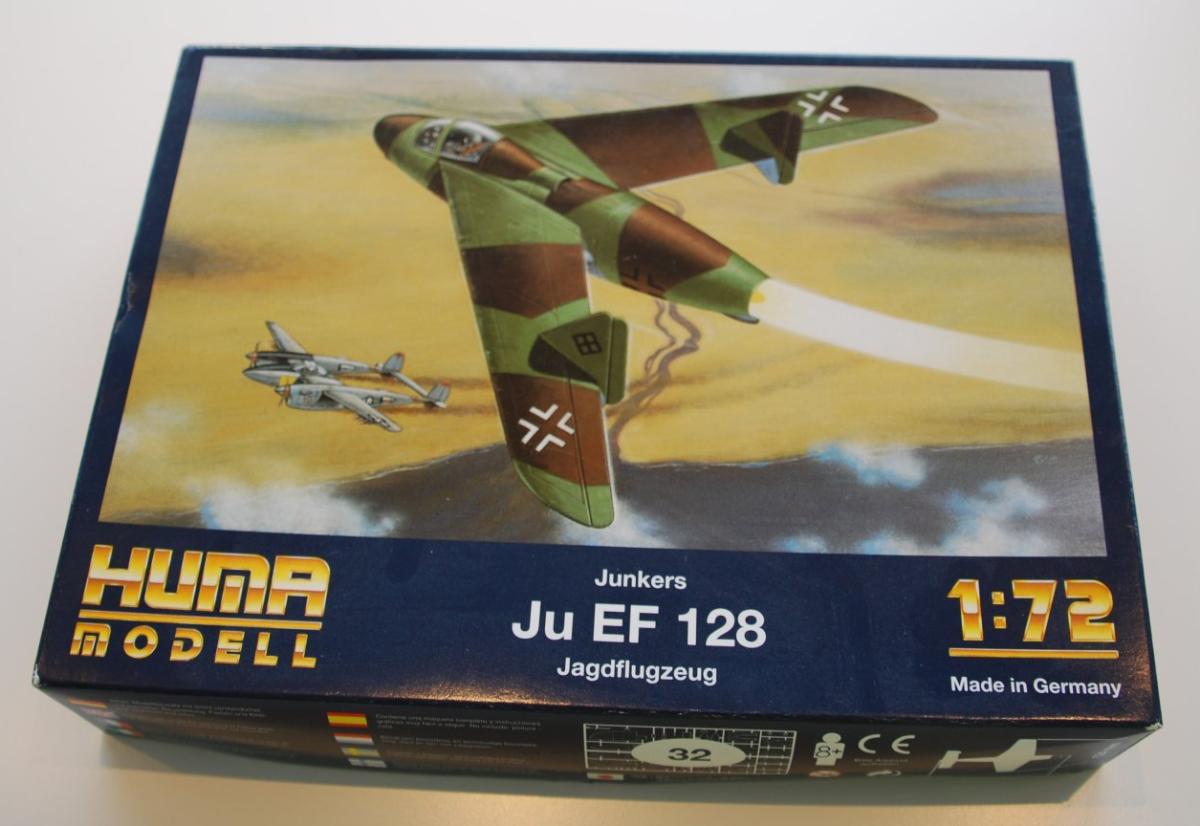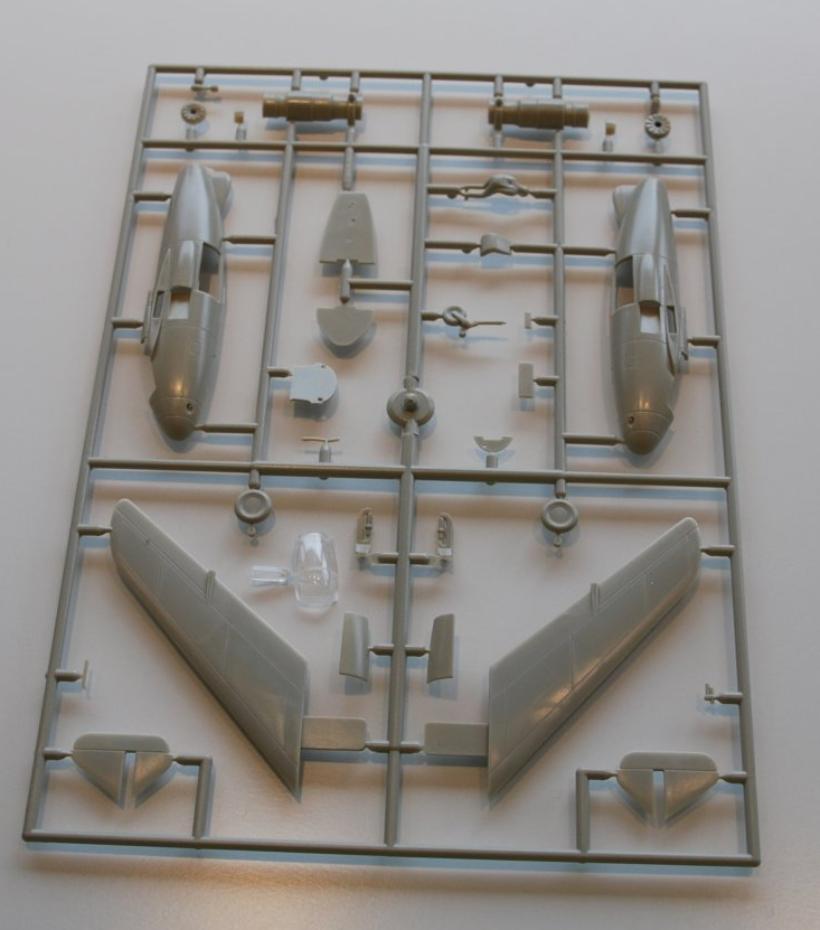Manufacturer: Huma
Scale: 1/72
Additional parts: parts from the spare part box
Model build: Jun-Jul 2015

Manufacturer: Huma
Scale: 1/72
Additional parts: parts from the spare part box
Model build: Jun-Jul 2015
The sky above central Germany was a grey veil of smoke and contrails. It was late April 1945, the Reich collapsing from every direction, yet the bombers still came. That morning, over 250 B-17 Flying Fortresses of the 1st Air Division thundered eastward, their target the industrial remains of Magdeburg and the bridges across the Elbe.
At Brandis airfield, near Leipzig, a handful of pilots gathered for what they knew might be their final flight. Among them was Oberleutnant Hans Keller, one of the first men assigned to fly the new Junkers EF 128. The aircraft was still experimental, barely tested, but desperate times demanded desperate weapons.
Mechanics pulled the wheel chocks away as Keller throttled the HeS 011 turbojet to full power. The compact, swept-wing jet leapt forward down the short grass strip, rattling violently until the wheels lifted free. Within seconds, Keller was climbing into the thick clouds, his speed pushing beyond 900 km/h. Behind him, Feldwebel Karl Brenner in the second prototype V2 followed, the two forming the only flight-ready Notjäger detachment in existence.
Climbing above 6,000 meters, the German pilots sighted the formation: a shimmering armada of B-17s in tight combat boxes, flanked by darting P-51 Mustangs. Radio chatter filled Keller’s ears — warnings from ground control, frantic voices from other units. But he ignored them. His orders were simple: strike the bombers, whatever the cost.
Rolling into a shallow dive, Keller armed the four MK 108 cannons mounted in the EF 128’s nose. The stubby 30 mm rounds were designed to shatter heavy bombers with a single hit. As he closed from the rear quarter of the lead squadron, the sky erupted with defensive fire. Tracers streaked past his canopy, shattering against nothingness, while the roar of the jet drowned out the thunder of machine guns.
At 400 meters he squeezed the trigger. The EF 128 spat fire — four streams of cannon shells converged into the flank of a B-17. The Fortress shuddered, its starboard wing ripped open, engines coughing smoke. Another burst and the tail section of a second bomber exploded in a spray of aluminum. Both aircraft fell out of formation, spiraling downward.
But the attack had drawn the hunters. Three P-51 Mustangs broke from the escort line, diving after Keller. Warnings screamed across his radio — “Achtung, Mustangs! Drei Uhr!” Brenner tried to turn into them, firing a long burst that forced one Mustang to break away, but the other two pressed their attack.
Keller shoved the throttle forward. The HeS 011 screamed as the EF 128 surged ahead. His pursuers followed, but the jet’s speed saved him. Diving into the clouds, Keller disappeared, his contrails slicing into the grey mist. For agonizing seconds, tracers whipped past his cockpit, but then the sky was empty. He leveled off low over the Elbe, heart pounding, fuel warning light blinking.
Behind him, Brenner’s V2 never returned. Witnesses later claimed they saw the second EF 128 go down in flames north of Stendal, swarmed by Mustangs.
Keller landed at Brandis on fumes, the jet skidding across the field as the undercarriage protested the rough landing. Mechanics swarmed the machine, counting the holes and scorch marks across its fuselage. Keller climbed out, exhausted, his leather helmet streaked with sweat.
It was the first and only combat sortie of the Junkers EF 128. Two bombers downed, one prototype lost — and nothing changed the fate of the war. But for a fleeting moment on April 27, 1945, the Luftwaffe’s last experiment had taken wing in battle.

The Junkers EF 128 was one of the most advanced designs to emerge from the German Jägernotprogramm (“Emergency Fighter Program”) of early 1945. Conceived as a successor to the Heinkel He 162 Volksjäger, the EF 128 was a compact, tailless jet fighter powered by the new Heinkel HeS 011 turbojet. Armed with four MK 108 30 mm cannons, the aircraft was projected to reach speeds approaching 1,000 km/h at combat altitude, making it one of the fastest fighter projects of the late war.
By March 1945, full construction plans were completed at the Dessau works, and several airframes were laid down for prototype assembly. The first prototype, EF 128 V1, took shape in late March and was readied for ground testing by mid-April. Despite the collapse of German industrial capacity, Junkers engineers managed to complete two flyable prototypes.
The EF 128 V1 made its maiden flight on 20 April 1945 from Brandis airfield near Leipzig, piloted by Flugkapitän Fritz Wendel. Reports from Luftwaffe observers confirm that the aircraft achieved stable flight characteristics at high speed, though with some instability in takeoff and landing due to its short fuselage and swept wing design. A second prototype, V2, joined trials shortly thereafter and conducted a brief series of operational evaluation flights.
Although the war situation rendered large-scale production impossible, the EF 128 was briefly deployed in late April 1945. A detachment of Jagdgeschwader 7 (Nowotny) received two pre-production aircraft, which were employed during the desperate defense of Berlin. On 27 April, one EF 128 is reported to have intercepted a formation of B-17 bombers near Stendal, damaging two before escaping pursuing P-51 Mustangs by diving at high speed into cloud cover.
At war’s end, both surviving prototypes were captured by advancing U.S. forces at Dessau. One example was shipped to Wright Field in the United States for evaluation under Operation Lusty, though no further development followed. The EF 128 remains notable as one of the last advanced jet fighters to fly under the Luftwaffe flag, representing the remarkable but ultimately futile efforts of the Emergency Fighter Program.

Its a 1/72 scale Huma kit, build OOB. Altough I added some weight to the nose, its still tail heavy. therefore I had to build a small support vehicle to keep the plane in the right position.
The model is painted with Revell Aqua Color and some additional decals from a Revell Me 262 were added.